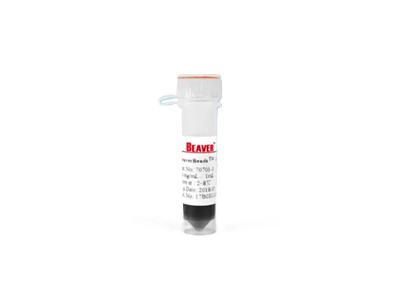- Home
- IVD
- By Technology Types
- By Diseases Types
- By Product Types
- Research
- Resource
- Distributors
- Company

| Product Name | Mag NHS-2 µm |
| Catalog No. | SM-HMM-0033 |
| Description | Mag NHS are polymer-based solid microspheres with the surface of the beads modified with NHS groups, with a particle size of 2 µm, which are able to form stable peptide bonds with proteins and other molecules with primary amine groups. They are mainly used in analytical assays (e.g., in vitro diagnostics, microbiological assays, immunoprecipitation, immunoprecipitation, etc.). |
| Features | Simple, no need for activation, can be directly covalently coupled with biological ligands; High efficiency, the coupling efficiency of biological ligands can reach more than 90%, which is much higher than that of carboxylated magnetic beads, and the binding load of ligands is higher at the same time; Rapid, 1~2 h to complete the coupling of biological ligands; Mild, room temperature or 4°Ccoupling, the pH of the coupling system is 5~9; Stable, forming stable amide bonds, preventing ligand detachment. Good biocompatibility, reduce non-specific adsorption. |
| Storage | 2-8°C |
| Average Particle Size | ~2 µm |
| Preservation Fluid | DMAC |
| Concentration | 10 mg/mL |
| Applications | In Vitro Diagnostics
Immunoassays Cell Sorting Immunoprecipitation/co-precipitation Protein/antibody Isolation and Purification |
Magnetic microspheres have become indispensable tools in modern scientific research, revolutionizing the way biological samples are processed, analyzed, and purified. With the rapid advancement of life sciences, there is an increasing demand for high-performance magnetic beads that offer reliability, efficiency, and versatility in various experimental workflows.
Mag NHS-2 µm microspheres are developed to address the critical needs of researchers in fields such as molecular biology, biochemistry, and immunology. These polymer-based solid microspheres are engineered with a precise particle size of ~2 µm, a dimension carefully selected to balance magnetic responsiveness and dispersion stability in aqueous solutions.
The surface modification with NHS (N-hydroxysuccinimide) groups is a key design feature. NHS esters are well-known for their ability to react specifically with primary amine (-NH2) groups present in proteins, antibodies, peptides, and other biomolecules. This reaction forms stable amide bonds, ensuring covalent coupling that withstands the rigors of experimental procedures such as washing, incubation, and separation.
Over the years, traditional coupling methods often required additional activation steps, increasing experimental complexity and the risk of ligand inactivation. Mag NHS-2 µm eliminates this barrier by providing pre-activated microspheres.
Researchers across academic institutions, research laboratories, and biotechnology companies rely on such tools to streamline assays, improve data reproducibility, and accelerate research progress.
The product is strictly intended for research use only, supporting applications that drive advancements in understanding biological processes, developing new research methodologies, and exploring novel biological targets.
Ready-to-use functionality: No pre-activation steps are required, allowing direct covalent coupling with biological ligands. This simplifies experimental workflows and saves valuable time.
Exceptional coupling efficiency: Achieves over 90% coupling efficiency, outperforming many carboxylated magnetic beads on the market.
High ligand binding capacity: At the same concentration, the beads offer a higher ligand binding load, ensuring sufficient interaction sites for target biomolecules.
Rapid coupling process: Completes biological ligand coupling in just 1–2 hours, enabling faster experimental turnarounds.
Mild reaction conditions: Coupling can be performed at room temperature or 4°C, with a compatible pH range of 5–9. This preserves the activity and integrity of sensitive biomolecules.
Stable bond formation: Forms durable amide bonds between the microspheres and ligands, preventing ligand detachment during experimental procedures.
Excellent biocompatibility: The polymer matrix is designed to minimize non-specific adsorption, reducing background noise and improving assay accuracy.
Precise particle size: With an average particle size of ~2 µm, the beads exhibit optimal magnetic responsiveness for efficient separation using standard magnetic separators.
Reliable storage: Maintains stability when stored at 2–8°C in DMAC preservation fluid, ensuring long-term product performance.
Simplifies experimental workflows: By eliminating pre-activation steps, it reduces the risk of operational errors and shortens the time from sample preparation to results.
Enhances assay sensitivity: High coupling efficiency and ligand binding capacity ensure that even low-abundance target molecules can be effectively captured and detected.
Preserves biomolecule activity: Mild coupling conditions protect the functional integrity of proteins, antibodies, and other ligands, ensuring reliable experimental outcomes.
Reduces experimental costs: The high coupling efficiency means less ligand is required per assay, lowering overall research expenses without compromising performance.
Improves data reproducibility: Stable amide bonds and minimal non-specific adsorption reduce variability between experiments, leading to more consistent and trustworthy results.
Versatile compatibility: Suitable for a wide range of research applications, from immunoprecipitation to protein purification, adapting to diverse experimental needs.
Easy to handle: The 2 µm particle size ensures smooth dispersion in solutions and efficient magnetic separation, compatible with standard laboratory equipment.
Research-focused design: Strictly optimized for research use, meeting the rigorous requirements of academic and industrial research laboratories.
For research use only, not for clinical use.
|
There is no product in your cart. |